|
|
|
GONIN (Guido)
Gravure signée et numérotée publiée par Ad Goubaud & fils, Paris dans la revue La Modiste Universelle. Revue de septembre 1881, planche n·238. D'après un dessin de Guido Gonin, dessinateur et lithographe (1833-1909).
Hervé Lefèvre imprimeur Paris. Septembre 1881. 35,5X26,5 Cm. Gravure en couleur de coiffe de femme. Délicatesse du dessin et détail de la coiffe. En très bon état. Papier épais avec quelques traces de pliure.
书商的参考编号 : 114467

|
|
|
GONCOURT Edmond de.
Outamaro - Le peintre des maisons vertes. Troisème mille.
1904 Paris, Bibliothèque Charpentier, Fasquelle éditeur, 1904; in-18° demi-basane bleu-nuit à coins, dos à nerfs muet, gardes et contreplats bleu vif, 1er plat de la couverture conservé; (2)ff., III, 265, (1)pp.
书商的参考编号 : 10007
|
|
|
Gonzalez Gerth Miguel with preface by Richmond Lattimore & wood engravings by John Roy
The Infinite Absence: poems
Iowa City: Printed for the author at The Stone Wall Press 1964. Hardcover. 20p. 8x5 inches landscape layout preface woodcuts tissue guards rubricated title page #169/250 limited first edition thus in sewn blue boards and gilt. Printed for the author at The Stone Wall Press hardcover
书商的参考编号 : 240569

|
|
|
Gonzalez Gerth Miguel with preface by Richmond Lattimore & wood engravings by John Roy
The Infinite Absence: poems
Iowa City: Printed for the author at The Stone Wall Press 1964. Hardcover. 20p. 8x5 inches landscape layout preface woodcuts tissue guards rubricated title page #169/250 limited first edition thus in sewn blue boards and gilt. Printed for the author at The Stone Wall Press hardcover books
书商的参考编号 : 240569

|
|
|
Goppelsröder, Friedrich:
Ueber die chemische Beschaffenheit von Basel's Grund-, Bach-, Fluss- & Quell-Wasser. Mit besonderer Berücksichtigung der sanitarischen Frage.
Basel, Schweighauserische Verlagsbuchhandlung, 1867. 8°. 97 S. Mit 9 Falttabellen. Pappband der Zeit (Rücken mit kleinen Rissen u. Materialverlust, berieben u. bestossen).
书商的参考编号 : 22500AB
|
|
|
Goppelsröder, Friedrich
Ueber die chemische Beschaffenheit von Basel's Grund-, Bach-, Fluss- & Quell-Wasser. Mit besonderer Berücksichtigung der sanitarischen Frage.
Basel, Schweighauserische Verlagsbuchhandlung, 1867. 8°. 97 S. Mit 9 Falttabellen. Pappband der Zeit (Rücken mit kleinen Rissen u. Materialverlust, berieben u. bestossen). + Wichtig: Für unsere Kunden in der EU erfolgt der Versand alle 14 Tage verzollt ab Deutschland / Postbank-Konto in Deutschland vorhanden +
书商的参考编号 : 22500AB
|
|
|
GORSE (P.)
[Estampe]. Manifestation religieuse et nationale à Notre-Dame de Lourdes. (Le 6 octobre 1872). [Lithographie originale].
Paris, Becquet, (1873). 64,2 x 44,2 cm à la composition + marges.
书商的参考编号 : 19854
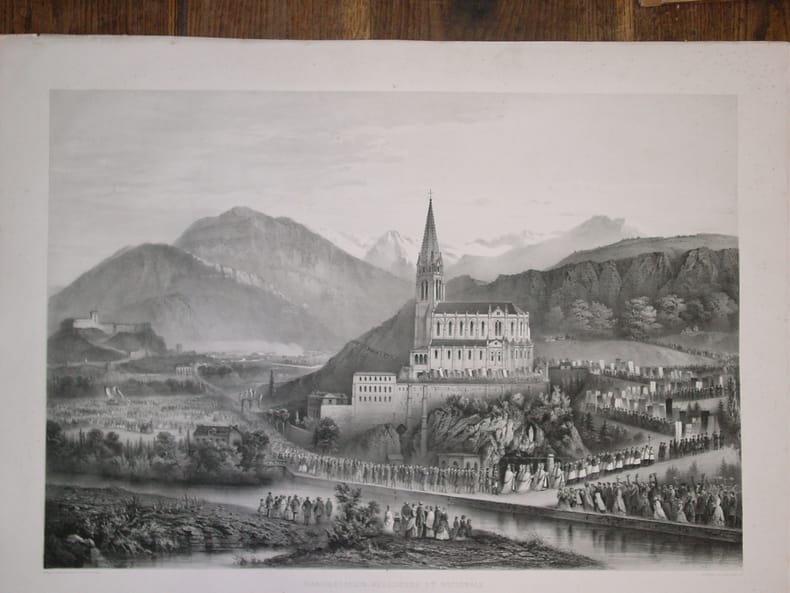
|
|
|
Gordon, Ayala [Curator]
Homage to the Jerusalem Print Workshop [IN HEBREW AND ENGLISH]
IN HEBREW AND ENGLISH. 21.5X21.5 cm. Unnumbered pages. Softcover. In good condition.
|
|
|
Gore Mrs.; Thomas Allom engravings
PARIS IN 1841 BY MRS. GORE
London 1842 first edition Longman Brown Gree. Hardcover. Large octavo 268p. illustrated with 21 engravings by Allom original lime green cloth with full floral gilt trim and original yellow end papers. All edges gilt. Good Plus light foxing on initial pages and on some of the plates spine faded to tan. Uneven discoloration on cover cloth. Binding secure; no ownership marks. . hardcover
书商的参考编号 : a88179
|
|
|
Gorelik, Sch. / Budko, Joseph [Artist] / Goldenring, Stefania; Strasser, Nadia [Tr.]
Jüdische Köpfe [WITH FOUR ORIGINAL LITHOGRAPHS]. Lithographien von Joseph Budko.
RARE book illustrated by Joseph Budko (1888-1940) - one of the greatest Jewish graphic artists, who started the revival of woodcut and one of the first great modern book illustrators. Includes FOUR ORIGINAL LITHOHRAPHS depicting Theodor Herzl, Marko Baruch, J.L.Perez, and Baruch Spinoza. 295x245mm. 114 pages. Illustrated board Hardcover with gilt cloth spine. Cover yellowing, age-stained, slightly stained and curved. Cover corners and edges bumped and peeling. Spine partly detached from binding (hinges partly cracked). Spine upper edge tattered, bottom edge missing. Ink writing on front whitepage upper edge. Inner cover and pages age-stained to various degrees. Some pages upper edge water-stained - no damage to text or plates. Pages yellowing, wavy and rough-cut (as published). [SUMMARY]: This extremely rare book with four original lithographs by one of the greatest modern Jewish artists is otherwise in good condition.
|
|
|
Gorr, Shmuel / Gelman, Manuel / Pins, Jacob [Illustr.]
Out of The Depths: Selected Poems and Essays [SIGNED AND DEDICATED BY AUTHOR'S SISTER] Limited Edition. Introduction by Manuel Gelman. Illustrated by Jacob Pins.
220x140mm. 20 pages. Gilt softcover. Inner cover illustrated. Cover corners/edges and spine edges slightly worn. Else in good condition.
|
|
|
GOSE Francisco Javier
Il a été primé. Robe du soir (pl.21, La Gazette du Bon ton, 1914 n°3)
Lucien Vogel éditeur, Paris Mars 1914, 19x24,5cm, une feuille.
书商的参考编号 : 84690
|
|
|
GOSE Georges
L'Arbre de mai. Robes simples pour l'été (pl.42, La Gazette du Bon ton, 1914 n°5)
Lucien Vogel éditeur, Paris Mai 1914, 36,5x24cm, une feuille.
书商的参考编号 : 54665
|
|
|
GOSE Georges
L'Arbre de mai. Robes simples pour l'été (pl.42, La Gazette du Bon ton, 1914 n°5)
Lucien Vogel éditeur, Paris Mai 1914, 36,5x24cm, une feuille.
书商的参考编号 : 84702
|
|
|
GOSE Francisco Javier
Suis-je belle ce soir ? Robe pour le casino (pl.63, La Gazette du Bon ton, 1914 n°7)
Lucien Vogel éditeur, Paris Juillet 1914, 18x24cm, une feuille.
书商的参考编号 : 54686
|
|
|
GOSE Francisco Javier
Il a été primé. Robe du soir (pl.21, La Gazette du Bon ton, 1914 n°3)
- Lucien Vogel éditeur, Paris Mars 1914, 19x24,5cm, une feuille. - Original color print, printed on vergé paper, signed in the plate. An original print used to illustrate the Gazette du bon ton, one of the most attractive and influential 20th century fashion magazines, featuring the talents of French artists and other contributors from the burgeoning Art Deco movement. A celebrated fashion magazine established in 1912 by Lucien Vogel, La Gazette du bon ton appeared until 1925, with a hiatus from 1915 to 1920 due to the war (the editor-in-chief having been called up for service). It consisted of 69 issues printed in only 2,000 copies each and notably illustrated with 573 color plates and 148 sketches of the models of the great designers. Right from the start, this sumptuous publication "was aimed at bibliophiles and fashionable society," (Françoise Tétart-Vittu, "La Gazette du bon ton", in Dictionnaire de la mode, 2016) and was printed on fine vergé paper using a type cut specially for the magazine by Georges Peignot, known as Cochin, later used (in 1946) by Christian Dior. The prints were made using stencils, heightened in colors, some highlighted in gold or palladium. The story began in 1912, when Lucien Vogel, a man of the world involved in fashion (he had already been part of the fashion magazine Femina) decided, with his wife Cosette de Brunhoff - the sister of Jean, creator of Babar - to set up the Gazette du bon ton, subtitled at the time: "Art, fashion, frivolities." Georges Charensol noted the reasoning of the editor-in-chief: "'In 1910,' he observed, 'there was no really artistic fashion magazine, nothing representative of the spirit of the time. My dream was therefore to make a luxury magazine with truly modern artists...I was assured of success, because when it comes to fashion, no country on earth can compete with France.'" ("Un grand éditeur d'art. Lucien Vogel" in Les Nouvelles littéraires, no. 133, May 1925). The magazine was immediately successful, not only in France but also in the United States and Latin America. At first, Vogel put together a team of seven artists: André-Édouard Marty and Pierre Brissaud, followed by Georges Lepape and Dammicourt, as well as eventually his friends from school and the School of Fine Arts, like George Barbier, Bernard Boutet de Monvel and Charles Martin. Other talented people soon came flocking to join the team: Guy Arnoux, Léon Bakst, Benito, Boutet de Monvel, Umberto Brunelleschi, Chas Laborde, Jean-Gabriel Domergue, Raoul Dufy, Édouard Halouze, Alexandre Iacovleff, Jean Émile Laboureur, Charles Loupot, Chalres Martin, Maggie Salcedo. These artist, mostly unknown when Lucien Vogel sought them out, later became emblematic and sought-after artistic figures. It was also they who worked on the advertising drawings for the Gazette. The plates put the spotlight on, and celebrate, dresses by seven designers of the age: Lanvin, Doeuillet, Paquin, Poiret, Worth, Vionnet and Doucet. The designers provided exclusive models for each issue. Nonetheless, some of the illustrations are not based on real models, but simply on the illustrator's conception of the fashion of the day. The Gazette du bon ton was an important step in the history of fashion. Combining aesthetic demands with the physical whole, it brought together - for the first time - the great talents of the artistic, literary, and fashion worlds; and imposed, through this alchemy, a completely new image of women: slender, independent and daring, which was shared by the new generation of designers, including Coco Chanel, Jean Patou, Marcel Rochas, and so on... Taken over in 1920 by Condé Montrose Nast, the Gazette du bon ton was an important influence on the new layout and aesthetics of that "little dying paper" that Nast had bought a few years earlier: Vogue. [FRENCH VERSION FOLLOWS] Estampe originale en couleur, tirée sur papier vergé, signée en bas à droite de la planche. Gravure originale réalisée pour l'il

|
|
|
GOSE Francisco Javier
Les Premières Roses. Costume Tailleur pour le matin (pl.2, La Gazette du Bon ton, 1912-1913 n°5)
- Lucien Vogel éditeur, Paris Mars 1913, 19x24,5cm, une feuille. - Original color print, printed on vergé paper, signed in the plate. An original print used to illustrate the Gazette du bon ton, one of the most attractive and influential 20th century fashion magazines, featuring the talents of French artists and other contributors from the burgeoning Art Deco movement. A celebrated fashion magazine established in 1912 by Lucien Vogel, La Gazette du bon ton appeared until 1925, with a hiatus from 1915 to 1920 due to the war (the editor-in-chief having been called up for service). It consisted of 69 issues printed in only 2,000 copies each and notably illustrated with 573 color plates and 148 sketches of the models of the great designers. Right from the start, this sumptuous publication "was aimed at bibliophiles and fashionable society," (Françoise Tétart-Vittu, "La Gazette du bon ton", in Dictionnaire de la mode, 2016) and was printed on fine vergé paper using a type cut specially for the magazine by Georges Peignot, known as Cochin, later used (in 1946) by Christian Dior. The prints were made using stencils, heightened in colors, some highlighted in gold or palladium. The story began in 1912, when Lucien Vogel, a man of the world involved in fashion (he had already been part of the fashion magazine Femina) decided, with his wife Cosette de Brunhoff - the sister of Jean, creator of Babar - to set up the Gazette du bon ton, subtitled at the time: "Art, fashion, frivolities." Georges Charensol noted the reasoning of the editor-in-chief: "'In 1910,' he observed, 'there was no really artistic fashion magazine, nothing representative of the spirit of the time. My dream was therefore to make a luxury magazine with truly modern artists...I was assured of success, because when it comes to fashion, no country on earth can compete with France.'" ("Un grand éditeur d'art. Lucien Vogel" in Les Nouvelles littéraires, no. 133, May 1925). The magazine was immediately successful, not only in France but also in the United States and Latin America. At first, Vogel put together a team of seven artists: André-Édouard Marty and Pierre Brissaud, followed by Georges Lepape and Dammicourt, as well as eventually his friends from school and the School of Fine Arts, like George Barbier, Bernard Boutet de Monvel and Charles Martin. Other talented people soon came flocking to join the team: Guy Arnoux, Léon Bakst, Benito, Boutet de Monvel, Umberto Brunelleschi, Chas Laborde, Jean-Gabriel Domergue, Raoul Dufy, Édouard Halouze, Alexandre Iacovleff, Jean Émile Laboureur, Charles Loupot, Chalres Martin, Maggie Salcedo. These artist, mostly unknown when Lucien Vogel sought them out, later became emblematic and sought-after artistic figures. It was also they who worked on the advertising drawings for the Gazette. The plates put the spotlight on, and celebrate, dresses by seven designers of the age: Lanvin, Doeuillet, Paquin, Poiret, Worth, Vionnet and Doucet. The designers provided exclusive models for each issue. Nonetheless, some of the illustrations are not based on real models, but simply on the illustrator's conception of the fashion of the day. The Gazette du bon ton was an important step in the history of fashion. Combining aesthetic demands with the physical whole, it brought together - for the first time - the great talents of the artistic, literary, and fashion worlds; and imposed, through this alchemy, a completely new image of women: slender, independent and daring, which was shared by the new generation of designers, including Coco Chanel, Jean Patou, Marcel Rochas, and so on... Taken over in 1920 by Condé Montrose Nast, the Gazette du bon ton was an important influence on the new layout and aesthetics of that "little dying paper" that Nast had bought a few years earlier: Vogue. [FRENCH VERSION FOLLOWS] Estampe originale en couleur, tirée sur papier vergé et signée en bas à droite dans la planche. Gravure originale réalisée pour

|
|
|
GOSE Francisco Javier
Suis-je belle ce soir ? Robe pour le casino (pl.63, La Gazette du Bon ton, 1914 n°7)
- Lucien Vogel éditeur, Paris Juillet 1914, 18x24cm, une feuille. - Double original color print, printed on vergé paper, signed in the plate. An original print used to illustrate the Gazette du bon ton, one of the most attractive and influential 20th century fashion magazines, featuring the talents of French artists and other contributors from the burgeoning Art Deco movement. A celebrated fashion magazine established in 1912 by Lucien Vogel, La Gazette du bon ton appeared until 1925, with a hiatus from 1915 to 1920 due to the war (the editor-in-chief having been called up for service). It consisted of 69 issues printed in only 2,000 copies each and notably illustrated with 573 color plates and 148 sketches of the models of the great designers. Right from the start, this sumptuous publication "was aimed at bibliophiles and fashionable society," (Françoise Tétart-Vittu, "La Gazette du bon ton", in Dictionnaire de la mode, 2016) and was printed on fine vergé paper using a type cut specially for the magazine by Georges Peignot, known as Cochin, later used (in 1946) by Christian Dior. The prints were made using stencils, heightened in colors, some highlighted in gold or palladium. The story began in 1912, when Lucien Vogel, a man of the world involved in fashion (he had already been part of the fashion magazine Femina) decided, with his wife Cosette de Brunhoff - the sister of Jean, creator of Babar - to set up the Gazette du bon ton, subtitled at the time: "Art, fashion, frivolities." Georges Charensol noted the reasoning of the editor-in-chief: "'In 1910,' he observed, 'there was no really artistic fashion magazine, nothing representative of the spirit of the time. My dream was therefore to make a luxury magazine with truly modern artists...I was assured of success, because when it comes to fashion, no country on earth can compete with France.'" ("Un grand éditeur d'art. Lucien Vogel" in Les Nouvelles littéraires, no. 133, May 1925). The magazine was immediately successful, not only in France but also in the United States and Latin America. At first, Vogel put together a team of seven artists: André-Édouard Marty and Pierre Brissaud, followed by Georges Lepape and Dammicourt, as well as eventually his friends from school and the School of Fine Arts, like George Barbier, Bernard Boutet de Monvel and Charles Martin. Other talented people soon came flocking to join the team: Guy Arnoux, Léon Bakst, Benito, Boutet de Monvel, Umberto Brunelleschi, Chas Laborde, Jean-Gabriel Domergue, Raoul Dufy, Édouard Halouze, Alexandre Iacovleff, Jean Émile Laboureur, Charles Loupot, Chalres Martin, Maggie Salcedo. These artist, mostly unknown when Lucien Vogel sought them out, later became emblematic and sought-after artistic figures. It was also they who worked on the advertising drawings for the Gazette. The plates put the spotlight on, and celebrate, dresses by seven designers of the age: Lanvin, Doeuillet, Paquin, Poiret, Worth, Vionnet and Doucet. The designers provided exclusive models for each issue. Nonetheless, some of the illustrations are not based on real models, but simply on the illustrator's conception of the fashion of the day. The Gazette du bon ton was an important step in the history of fashion. Combining aesthetic demands with the physical whole, it brought together - for the first time - the great talents of the artistic, literary, and fashion worlds; and imposed, through this alchemy, a completely new image of women: slender, independent and daring, which was shared by the new generation of designers, including Coco Chanel, Jean Patou, Marcel Rochas, and so on... Taken over in 1920 by Condé Montrose Nast, the Gazette du bon ton was an important influence on the new layout and aesthetics of that "little dying paper" that Nast had bought a few years earlier: Vogue. [FRENCH VERSION FOLLOWS] Estampe double originale en couleur, tirée sur papier vergé, signée en bas à droite de la planche. Gravure originale réa

|
|
|
GOSE Georges
L'Arbre de mai. Robes simples pour l'été (pl.42, La Gazette du Bon ton, 1914 n°5)
- Lucien Vogel éditeur, Paris Mai 1914, 36,5x24cm, une feuille. - Double original color print heightened with gold, printed on vergé paper, signed in the plate. An original print used to illustrate the Gazette du bon ton, one of the most attractive and influential 20th century fashion magazines, featuring the talents of French artists and other contributors from the burgeoning Art Deco movement. A celebrated fashion magazine established in 1912 by Lucien Vogel, La Gazette du bon ton appeared until 1925, with a hiatus from 1915 to 1920 due to the war (the editor-in-chief having been called up for service). It consisted of 69 issues printed in only 2,000 copies each and notably illustrated with 573 color plates and 148 sketches of the models of the great designers. Right from the start, this sumptuous publication "was aimed at bibliophiles and fashionable society," (Françoise Tétart-Vittu, "La Gazette du bon ton", in Dictionnaire de la mode, 2016) and was printed on fine vergé paper using a type cut specially for the magazine by Georges Peignot, known as Cochin, later used (in 1946) by Christian Dior. The prints were made using stencils, heightened in colors, some highlighted in gold or palladium. The story began in 1912, when Lucien Vogel, a man of the world involved in fashion (he had already been part of the fashion magazine Femina) decided, with his wife Cosette de Brunhoff - the sister of Jean, creator of Babar - to set up the Gazette du bon ton, subtitled at the time: "Art, fashion, frivolities." Georges Charensol noted the reasoning of the editor-in-chief: "'In 1910,' he observed, 'there was no really artistic fashion magazine, nothing representative of the spirit of the time. My dream was therefore to make a luxury magazine with truly modern artists...I was assured of success, because when it comes to fashion, no country on earth can compete with France.'" ("Un grand éditeur d'art. Lucien Vogel" in Les Nouvelles littéraires, no. 133, May 1925). The magazine was immediately successful, not only in France but also in the United States and Latin America. At first, Vogel put together a team of seven artists: André-Édouard Marty and Pierre Brissaud, followed by Georges Lepape and Dammicourt, as well as eventually his friends from school and the School of Fine Arts, like George Barbier, Bernard Boutet de Monvel and Charles Martin. Other talented people soon came flocking to join the team: Guy Arnoux, Léon Bakst, Benito, Boutet de Monvel, Umberto Brunelleschi, Chas Laborde, Jean-Gabriel Domergue, Raoul Dufy, Édouard Halouze, Alexandre Iacovleff, Jean Émile Laboureur, Charles Loupot, Chalres Martin, Maggie Salcedo. These artist, mostly unknown when Lucien Vogel sought them out, later became emblematic and sought-after artistic figures. It was also they who worked on the advertising drawings for the Gazette. The plates put the spotlight on, and celebrate, dresses by seven designers of the age: Lanvin, Doeuillet, Paquin, Poiret, Worth, Vionnet and Doucet. The designers provided exclusive models for each issue. Nonetheless, some of the illustrations are not based on real models, but simply on the illustrator's conception of the fashion of the day. The Gazette du bon ton was an important step in the history of fashion. Combining aesthetic demands with the physical whole, it brought together - for the first time - the great talents of the artistic, literary, and fashion worlds; and imposed, through this alchemy, a completely new image of women: slender, independent and daring, which was shared by the new generation of designers, including Coco Chanel, Jean Patou, Marcel Rochas, and so on... Taken over in 1920 by Condé Montrose Nast, the Gazette du bon ton was an important influence on the new layout and aesthetics of that "little dying paper" that Nast had bought a few years earlier: Vogue. [FRENCH VERSION FOLLOWS] Estampe double originale en couleur rehaussée à l'or, tirée sur papier vergé, signée en bas à gauche

|
|
|
GOUDIACHVILI Lado
Paysage (pl.39, La Gazette du Bon ton, 1924-1925 n°5)
Lucien Vogel éditeur, Paris 1924-1925, 18x24cm, une feuille.
书商的参考编号 : 55162
|
|
|
GOULD (J).
Platycercus Pennantii.
Hullmandel & Walton, 1955 Dimensions: 40,0 x 29,5 cm Très belle lithographie en coleurs en bon état de deux platycercus Pennantii de "Goulds tropical Birds". Edition limité.
书商的参考编号 : 108374
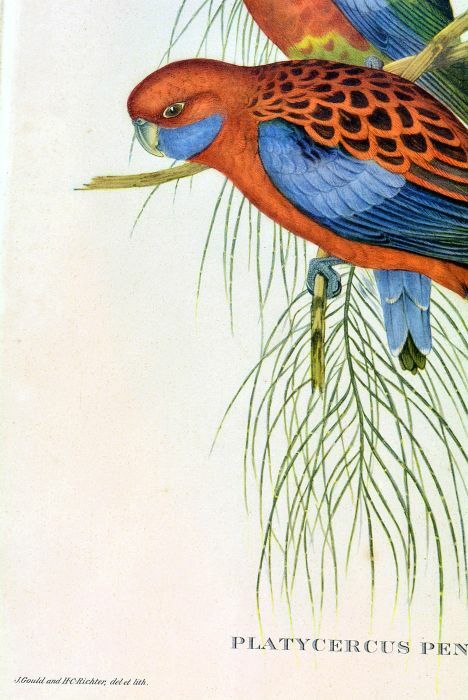
|
|
|
GOULD (John et Elisabeth).
TROGON AMBIGUUS.
S.l,n.d. 42x31 Cm. Dimension gravure: Environ 39x28 Cm. Cette gravure est une illustration naturaliste réalisée par John Gould, un célèbre ornithologue et artiste du 19e siècle, et son épouse Elizabeth Gould, également talentueuse illustratrice. Le nom scientifique Trogon Ambiguus désigne une espèce d'oiseau trogon, probablement le Trogon ambiguus, également connu sous le nom de Trogon de montagne (Mountain Trogon). Cette gravure provient probablement de l’ouvrage "A Monograph of the Trogonidae, or Family of Trogons", publié par John Gould entre 1835 et 1838. Cet ouvrage est dédié à la famille des trogons, des oiseaux exotiques colorés des régions tropicales d’Amérique, d’Asie et d’Afrique. Cadre simple en bois.
书商的参考编号 : 117407

|
|
|
GOUDIACHVILI Lado
Marchand de yaourt (pl.40, La Gazette du Bon ton, 1924-1925 n°5)
- Lucien Vogel éditeur, Paris 1924-1925, 18x24cm, une feuille. - Original color print, printed on vergé paper, non signed. An original print used to illustrate the Gazette du bon ton, one of the most attractive and influential 20th century fashion magazines, featuring the talents of French artists and other contributors from the burgeoning Art Deco movement. A celebrated fashion magazine established in 1912 by Lucien Vogel, La Gazette du bon ton appeared until 1925, with a hiatus from 1915 to 1920 due to the war (the editor-in-chief having been called up for service). It consisted of 69 issues printed in only 2,000 copies each and notably illustrated with 573 color plates and 148 sketches of the models of the great designers. Right from the start, this sumptuous publication "was aimed at bibliophiles and fashionable society," (Françoise Tétart-Vittu, "La Gazette du bon ton", in Dictionnaire de la mode, 2016) and was printed on fine vergé paper using a type cut specially for the magazine by Georges Peignot, known as Cochin, later used (in 1946) by Christian Dior. The prints were made using stencils, heightened in colors, some highlighted in gold or palladium. The story began in 1912, when Lucien Vogel, a man of the world involved in fashion (he had already been part of the fashion magazine Femina) decided, with his wife Cosette de Brunhoff - the sister of Jean, creator of Babar - to set up the Gazette du bon ton, subtitled at the time: "Art, fashion, frivolities." Georges Charensol noted the reasoning of the editor-in-chief: "'In 1910,' he observed, 'there was no really artistic fashion magazine, nothing representative of the spirit of the time. My dream was therefore to make a luxury magazine with truly modern artists...I was assured of success, because when it comes to fashion, no country on earth can compete with France.'" ("Un grand éditeur d'art. Lucien Vogel" in Les Nouvelles littéraires, no. 133, May 1925). The magazine was immediately successful, not only in France but also in the United States and Latin America. At first, Vogel put together a team of seven artists: André-Édouard Marty and Pierre Brissaud, followed by Georges Lepape and Dammicourt, as well as eventually his friends from school and the School of Fine Arts, like George Barbier, Bernard Boutet de Monvel and Charles Martin. Other talented people soon came flocking to join the team: Guy Arnoux, Léon Bakst, Benito, Boutet de Monvel, Umberto Brunelleschi, Chas Laborde, Jean-Gabriel Domergue, Raoul Dufy, Édouard Halouze, Alexandre Iacovleff, Jean Émile Laboureur, Charles Loupot, Chalres Martin, Maggie Salcedo. These artist, mostly unknown when Lucien Vogel sought them out, later became emblematic and sought-after artistic figures. It was also they who worked on the advertising drawings for the Gazette. The plates put the spotlight on, and celebrate, dresses by seven designers of the age: Lanvin, Doeuillet, Paquin, Poiret, Worth, Vionnet and Doucet. The designers provided exclusive models for each issue. Nonetheless, some of the illustrations are not based on real models, but simply on the illustrator's conception of the fashion of the day. The Gazette du bon ton was an important step in the history of fashion. Combining aesthetic demands with the physical whole, it brought together - for the first time - the great talents of the artistic, literary, and fashion worlds; and imposed, through this alchemy, a completely new image of women: slender, independent and daring, which was shared by the new generation of designers, including Coco Chanel, Jean Patou, Marcel Rochas, and so on... Taken over in 1920 by Condé Montrose Nast, the Gazette du bon ton was an important influence on the new layout and aesthetics of that "little dying paper" that Nast had bought a few years earlier: Vogue. [FRENCH VERSION FOLLOWS] Estampe originale en couleur, tirée sur papier vergé, non-signée. Gravure originale réalisée pour l'illustration de La Gazette du bon ton

|
|
|
GOUDIACHVILI Lado
Paysage (pl.39, La Gazette du Bon ton, 1924-1925 n°5)
- Lucien Vogel éditeur, Paris 1924-1925, 18x24cm, une feuille. - Original color print, printed on vergé paper, signed in the plate. An original print used to illustrate the Gazette du bon ton, one of the most attractive and influential 20th century fashion magazines, featuring the talents of French artists and other contributors from the burgeoning Art Deco movement. A celebrated fashion magazine established in 1912 by Lucien Vogel, La Gazette du bon ton appeared until 1925, with a hiatus from 1915 to 1920 due to the war (the editor-in-chief having been called up for service). It consisted of 69 issues printed in only 2,000 copies each and notably illustrated with 573 color plates and 148 sketches of the models of the great designers. Right from the start, this sumptuous publication "was aimed at bibliophiles and fashionable society," (Françoise Tétart-Vittu, "La Gazette du bon ton", in Dictionnaire de la mode, 2016) and was printed on fine vergé paper using a type cut specially for the magazine by Georges Peignot, known as Cochin, later used (in 1946) by Christian Dior. The prints were made using stencils, heightened in colors, some highlighted in gold or palladium. The story began in 1912, when Lucien Vogel, a man of the world involved in fashion (he had already been part of the fashion magazine Femina) decided, with his wife Cosette de Brunhoff - the sister of Jean, creator of Babar - to set up the Gazette du bon ton, subtitled at the time: "Art, fashion, frivolities." Georges Charensol noted the reasoning of the editor-in-chief: "'In 1910,' he observed, 'there was no really artistic fashion magazine, nothing representative of the spirit of the time. My dream was therefore to make a luxury magazine with truly modern artists...I was assured of success, because when it comes to fashion, no country on earth can compete with France.'" ("Un grand éditeur d'art. Lucien Vogel" in Les Nouvelles littéraires, no. 133, May 1925). The magazine was immediately successful, not only in France but also in the United States and Latin America. At first, Vogel put together a team of seven artists: André-Édouard Marty and Pierre Brissaud, followed by Georges Lepape and Dammicourt, as well as eventually his friends from school and the School of Fine Arts, like George Barbier, Bernard Boutet de Monvel and Charles Martin. Other talented people soon came flocking to join the team: Guy Arnoux, Léon Bakst, Benito, Boutet de Monvel, Umberto Brunelleschi, Chas Laborde, Jean-Gabriel Domergue, Raoul Dufy, Édouard Halouze, Alexandre Iacovleff, Jean Émile Laboureur, Charles Loupot, Chalres Martin, Maggie Salcedo. These artist, mostly unknown when Lucien Vogel sought them out, later became emblematic and sought-after artistic figures. It was also they who worked on the advertising drawings for the Gazette. The plates put the spotlight on, and celebrate, dresses by seven designers of the age: Lanvin, Doeuillet, Paquin, Poiret, Worth, Vionnet and Doucet. The designers provided exclusive models for each issue. Nonetheless, some of the illustrations are not based on real models, but simply on the illustrator's conception of the fashion of the day. The Gazette du bon ton was an important step in the history of fashion. Combining aesthetic demands with the physical whole, it brought together - for the first time - the great talents of the artistic, literary, and fashion worlds; and imposed, through this alchemy, a completely new image of women: slender, independent and daring, which was shared by the new generation of designers, including Coco Chanel, Jean Patou, Marcel Rochas, and so on... Taken over in 1920 by Condé Montrose Nast, the Gazette du bon ton was an important influence on the new layout and aesthetics of that "little dying paper" that Nast had bought a few years earlier: Vogue. [FRENCH VERSION FOLLOWS] Estampe originale en couleur, tirée sur papier vergé, signée en bas à gauche de la planche. Gravure originale réalisée pour l'illu

|
|
|
Gough John B. John Bartholomew & Steel Engravings
Sunlight and Shadows; or Gleanings from My Life Work Comprising Personal Experiences and Opinions Anecdotes Incidents and Reminiscences Gathered from Thirty-Seven Years; Experience on the Platform and Among the People at Home and Abroad
A.D. Worthington Anc Company. Very Good- with no dust jacket. 1881. Hardcover. 542 pp; Book is sunned on spine slightly shaken wear to corners and spine ends endpapers and tissue covering frontis portrait are foxed. Cover gilt very bright and flat embossed decorative border nice. Still a nice solid and attractive copy. Temperance advocate and speaker based on his personal experiences with alcoholism. . A.D. Worthington Anc Company hardcover
书商的参考编号 : 302243
|
|
|
GOYA Francisco / MICKO Miroslav ( texte de )
LES CAPRICES
Paris Editions Cercle d'Art 1960 in 4 (27,5x21,5) 1 volume reliure toilée de l'éditeur sous jaquette illustrée, 29 pages, suivies des reproductions horrs-texte (légendées en regard) des 80 planches des ''Caprices'' de Goya, et de 16 pages (titres,commentaires de Goya et notes). Bel exemplaire ( Photographies sur demande / We can send pictures of this book on simple request )
书商的参考编号 : 36991
|
|
|
Grandville (Nancy, 15–09–1803 - Vanves, 17–03–1847) -Desperet ou Desperret, Auguste
... empressées 1833 - Lithographie, Coloriée - Voyage de la pensée immuable à travers les populations empressées: 3 -Hand-coloured lithograph,
1833 Planche HT double parue dans La Caricature politique, morale, littéraire et scénique, volume 6, 7 novembre 1833 (n°328-329) : Hauteur: 35.8cmx Largeur: 53cm- Image Hauteur: 22cm x Largeur: 53cmDescription:Titre en ht au centre : « EMPRESSÉES. » ; légendes, en bas, de gche à dte : « L’omnibus trainé [traîné] par les quatre boiteuses. », « Les Débats. », « Le Constitutionnel. », « Le Moniteur. », « Le Journal de Paris. » ; indications : en ht au centre : « La Caricature (Journal) N°157. », en ht à dte : « Pl. 328 et 329. »Inscription - Dans la lettre : « L. de Becquet, rue Furstemberg. 9. » [imprimeur], « Chez Aubert, galerie véro d […] [dodat] » [feuille coupée] [éditeur] ; dans l’image, en bas au centre, signature : « G. invt A.D. » [Jean-Jacques Grandville, dessinateur, et Auguste Desperet, lithographe]Inscription - Sur le nez de d’Argout, inscription : « DE PARIS A LISIEUX ». Sur le devant de la cabine du cocher, le slogan « VIVE LE RÔA » : « le cocher, en appuyant le pied sur un petit buffet d’orgue, peut, au moyen de cet appareil, produire un volume satisfaisant d’amour unanime » (in explication)Description iconographique: Pl. n°5 et 6 du "Voyage de la pensée immuable à travers les populations empressées". Cf. pl. n°1 et 2 (pl. 324-325 du numéro 155) et pl. n°3 et 4 (pl. 326-327 du numéro 156). Les deux dernières pl. de la série montrent « l’auguste omnibus, traîné par ses quatre boiteuses » (in explication), c'est-à-dire un carrosse traîné par des chevaux. Sur le toit du carrosse sont assis, de gche à dte : d’Argout, faisant le cocher, un homme de dos (« M. Faim », in explication), Montalivet habillé en cuisiner et tenant une casserole, et Barthe. L’emblème de la monarchie de Juillet imaginé par Grandville se trouve sur le la petite cabine du cocher : il est constitué d’une grande paire de ciseaux ouverts, entourée d’un parapluie, d’une seringue à clystère, d’un chapeau à cocarde tricolore et d’une toque de magistrat. Deux municipaux, « M. Corneille, adjoint d’Evreux, et M. Criquet, maire de Falaise » (in explication) se cramponnent au carrosse (au marche-pied et à la portière arrière) afin de saluer Madame Adélaïde se trouvant à l’intérieur. L’un d’eux souhaite lui offrir un bouquet de fleurs. Des motifs partiels de poire à face humaine décorent le carrosse. A l’arrière-plan, des petits enfants montés sur les branches d’un arbre lèvent le poing au passage du cortège. Derrière le carrosse suivent les incarnations des journaux, sous la forme d’hommes pourvus d’attributs. Le Journal des débats, portant un pantalon fleurdelysé et une poire sur son bicorne, prend des notes sur un petit carnet. "Le Constitutionnel", écrivant sur un cahier dont le titre a le nom du journal, porte un bonnet et tient une vessie au bout d’un bâton sur laquelle peut se lire « ON SE // DESABONN […] [DESABONNE] » ("La Caricature" se moque fréquemment des désabonnements dont est victime ce journal). Un sac d’argent pend de son pantalon (« 1,000 »). Son encrier, accroché à son vêtement, à la forme du buste de Dupin en habit de magistrat. Enfin, « son araignée dilettante » (in explication) court à côté de lui, au bout d’un fil. Puis vient le "Moniteur", « avec ses plumes d’oie et son appareil vélocipède » (in explication). Il est coiffé d’un chapeau en forme de poire à face humaine. A la bicyclette sont accrochés de nombreux symboles des différents régimes successifs en France : la poire à tête de Louis-Philippe de la monarchie de Juillet, la fleur de lys monarchique (représentée à l’envers), le bonnet phrygien à cocarde tricolore, et l’aigle de l’Empire (représenté à l’envers). La tête d’un homme (non identifié) pend dans son dos. Enfin, le "Journal de Paris" ferme la marche : homme barbu et pourvu de gros favoris, il porte un haut chapeau décoré du motif de la poire à face humaine de Louis-Philippe. Il est décoré de la croix d’honneur. Il porte un gros encrier en bandoulière dans le dos. Il est « le seul journal qui n’écrive point, par l’excellente raison qu’il ne sait pas écrire » (in explication). A l’extrême gche, à l’arrière-plan, des enfants du peuple montés sur des branches d’arbres, lèvent le poing en signe de protestation.
书商的参考编号 : 25194
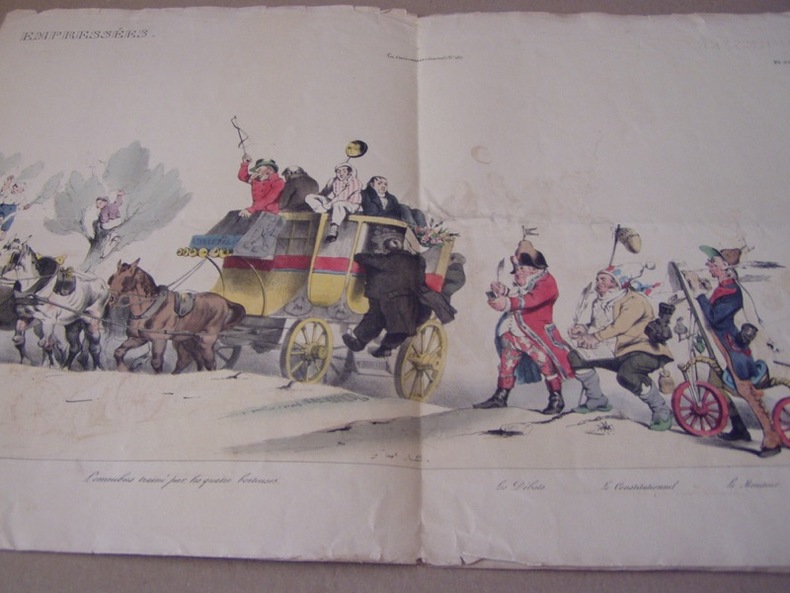
|
|
|
GRANDVILLE et FOREST.[PRESTIDIGITATION].
[PRESTIDIGITATION].- Mr Bosco, prestidigitateur.Lithographie originale sur Velin blanc
1832 1832. Lithographie.[PRESTIDIGITATION]. GRANDVILLE et FOREST. Mr Bosco, prestidigitateur. Pl. 223. 250 x 225. Vic. col. 65.Planche 223 de La Caricature N° 108.La Caricature, 29 novembre 1832. Lithographie originale sur Velin blanc,un peu jaunie,plis
书商的参考编号 : 25105
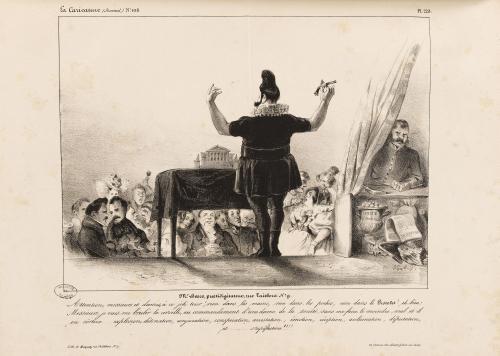
|
|
|
Grandville JJ - Forest, Eugène-Hippolyte
Artillerie du diable.Lithographie sur blanc.
1834 Planc he HT parue dans La Caricature politique, morale, littéraire et scénique, volume 7, 20 mars 1834 (Planche n°371)- Lithographie - Œuvre: Hauteur: 27cmx Largeur: 35.5cm - Image: Hauteur: 18cmx Largeur: 29.2cm - Titre en bas au centre : « Artillerie du diable. » ; légende plus bas au centre : « inventée perfectionnée et manœuvrée à la grande admiration des députés vendus. // (Journée du 23 février 1834) » ; indications : en ht à gche : « La Caricature (Journal) N°176. », en ht à dte : « Pl. 371. »Inscription - Dans la lettre : « chez Aubert, galerie véro dodat. » [éditeur], « Litho. de Benard. » [imprimeur] ; dans l’image, en bas à gche, signature : « J.J. Grand….. // Eug. For…. » [Jean-Jacques Grandville, dessinateur, et Eugène Forest, lithographe]Inscription - Sur les feuilles volantes expulsées par le derrière de la machine d’Argout : « Loi contre // la presse // populaire », « Censure // Dramatique », « Loi contre les // associations » (référence à la loi réglementant le régime des associations alors en passe d’être votée. La loi fut adoptée par les députés le 26 mars 1834, et par les pairs le 9 avril. Elle fut promulguée dès le lendemain), « Condamnation // de // Cabet » (un des principaux dirigeants de la Charbonnerie, Etienne Cabet fut ensuite élu député en 1831 et se lança vivement dans l’opposition. Il fut condamné en 1834 à deux ans de prison pour délit de presse), « Condamnation // du // National » (évocation du journal d’opposition Le National)
书商的参考编号 : 25631

|
|
|
Gravures de REDOUTÉ, BESLER et divers artistes - textes de Matthias HERMANN
Au paradis des fleurs sauvages
1986 Editions Minerva - 1986 - In-4, cartonné, couverture illustrée en couleurs - 128 p. - Nombreuses illustrations en couleurs hors-texte
书商的参考编号 : 84712
|
|
|
Grandville (Nancy, 15–09–1803 - Vanves, 17–03–1847),- Julien, Bernard-Romain (Bayonne, 16–11–1802 - Bayonne, 03–12–1871), dessinateur-lithographe
Barbe bleue, blanche, rouge, Lithographie- La pl. se réfère à Barbe bleue, conte de Charles Perrault ( 1697).
1833 La Caricature politique, morale, littéraire et scénique - 1833- Lithographie- Hauteur: 27.3cmx Largeur: 35.8cm- Hauteur: 20.3cmx Largeur: 23.7cm- Planche HT parue dans La Caricature politique, morale, littéraire et scénique, volume 5, 11 avril 1833 (Planche n°263)- Titre en ht au centre : « Barbe bleue, blanche, rouge. » ; légende en bas au centre : « La presse, ma sœur, ne vois-tu rien venir ? – je ne vois que le soleil de Juillet qui poudroie et l’herbe des // tombeaux qui verdoie. – Presse, ma sœur, ne vois-tu rien encore ? – je vois deux cavaliers qui viennent // au galop, portant une bannière. » ; indications : en ht à gche : « La Caricature (Journal) N°127. », en ht à dte : « Pl. 263. »Inscription - Dans la lettre : « L. de Becquet, rue furstemberg N°6. » [imprimeur], « On s’abonne chez Aubert, galerie véro dodat. » [éditeur] ; dans l’image, en bas à gche, signature : « G. = et Jn » [Jean-Jacques Grandville, dessinateur, et Bernard-Romain Julien, lithographe ?]- Inscription - Sur la feuille volante posée à terre à côté de la Constitution : « LOI ,qques taches.
书商的参考编号 : 25914

|
|
|
GRASSET de SAINT SAUVEUR Jacques (GRAVURE)
Chef de l'isle de Ste Christine.
1788 1788 Gravure a l'aquatinte du 18e siecle (1788) par Labrousse, d'apres le dessin de Grasset St Sauveur, Coloriee a la main a l'époque.Encyclopédie des voyages,Kolorierte Aquatinta, Darstellung: 11 x 17 cm
书商的参考编号 : 17271
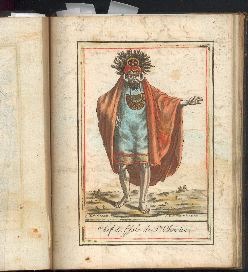
|
|
|
Grandville & E.Forest.-
Cérémonie des cendres politiques. (Suite) Lithographie, Coloriée Hand-coloured lithograph,-
1833 Planche HT parue dans La Caricature politique, morale, littéraire et scénique, volume 5, 28 février 1833 (Planche n°250) - Hauteur: 27.3cm x Largeur: 35.8cmDimensions - Image :Hauteur: 20cmx Largeur: 28cmTitre en ht au centre : « Cérémonie des cendres politiques. // (Suite) » ; légendes en bas, de gche à dte: « Pere [Père]-Scie, // ange de la morgue. », « Madrier-Longeau, // Girafe. », « Nargout », « Guizotin // doctrinain. », « Berthe en poissarde », « Bey-dok en marlou. », « Chonaine et // Stephanus // ivres…de joie. », « leur valet // en Figaro. », « M. Vienn.. », « Air du déserteur », et, sous une partition de musique : « Le roi pas-sait [passait] etc etc » ; indications : en ht à dte : « La Caricature (Journal) Pl. 250 // N°121. »Inscription - Dans la lettre : « L. de Becquet, rue Childebert N°9. » [imprimeur], « On s’abonne chez Aubert, galerie véro dodat. » ; dans l’image, en bas à gche, signature : « JJ. Grandville // E. Forest » [Jean-Jacques Grandville, dessinateur, et Eugène Forest, lithographe]Pl. n°2 de la série "Cérémonie des cendres politiques". Cf. pl. n°1 (pl. 248 du numéro 120) et pl. n°3 (pl. 251 du numéro 121). Suite du cortège dans lequel on peut reconnaître : Persil en bourreau, affublé d’un grand nez en forme de scie dont le bout est rougi par le sang, portant la coiffe de magistrat, portant un tablier de boucher où apparaît le portrait d’un homme et sur lequel peut se lire « PEINE // DE // MORT // TOUJOURS ! // 5000000000000 // AMENDES ». Il porte une hache de la main dte (décorée d’une poire), tandis que sa main gche est salie par du sang. Madier de Montjau chevauche une fausse girafe pourve de deux jambes d’hommes montées sur des échasses. La girafe est couverte par un carapaçon orné du motif de la poire à face humaine (Louis-Philippe). D’Argout en polichinelle vient ensuite, son costume ayant pris la forme de son grand nez au niveau du buste. Puis Guizot, en ecclésiastique tenant un petit ouvrage ouvert, fervent défenseur de la doctrine, « Berthe en poissarde », « Bey-dok en marlou » (identification difficile de ces deux personnages), puis Schonen, et la figure du "Constitutionnel", soutenu par l’incarnation du journal "Le Figaro" lequel, partageant depuis 1832 les idées du gouvernement, se fait maintenant le soutien de ses membres (« veut les relever de la boue dans laquelle il les a traînés si longtemps » in explication). Se trouve ensuite Viennet récitant des airs d’orgue de Barbarie décoré d’un motif de poire. La pl. se moque de son activité de poète.
书商的参考编号 : 25196

|
|
|
Grandville , Forest, Eugène-Hippolyte
Digestion du Budjet ; travail administratif, politique, moral et surtout économique.- Lithographie sur blanc.
Planche HT parue dans La Caricature morale, religieuse, littéraire et scénique, volume 4, 24 mai 1832 (Planche n°165)- Lithographie - Œuvre: Hauteur: 27cmx Largeur: 35.6cm - Image: Hauteur: 16.9cmx Largeur: 30.9cm - Titre en bas au centre : « Digestion du Bugjet [Budget] // travail administratif, politique, moral et surtout économique. » ; indications, en ht au centre : « La Caricature (Journal.) // (N°82) », en ht à dte : « Pl. 165. »Inscription - Dans la lettre : « Lith. de Becquet, rue Childebert N°9. » [imprimeur], « On s’abonne chez Aubert, galerie véro dodat. » [éditeur] ; dans l’image, en bas à gche, signature : « J.J.G.E.F. » [Jean-Jacques Grandville, dessinateur, et Eugène Forest, lithographe]Inscription - Sur les liasses de feuilles en bas à gche, inscriptions : « CHATEA [CHATEAUX] », « DOTATIONS // N°150 [ ?] », [ ?] PROVISOIRE » ; sur la trappe ouverte à dte, inscription : « FONDS SECRETS »
书商的参考编号 : 25636
|
|
|
Grandville , Forest, Eugène-Hippolyte
Donnez moi la première chose venue Lithographie sur blanc.
Planche HT parue dans La Caricature politique, morale, littéraire et scénique, volume 4, 11 octobre1832 (Planche n°208)- Lithographie,pli central - ŒuvreHauteur: 27cmx Largeur: 35.6cm - Image: Hauteur: 24.6cmx Largeur: 18.4cm - Titre en bas au centre : « Donnez moi la première chose venue » ; légende plus bas au centre : « (La scène se passe chez le Pharmacien royal. – il s’agit // de composer un remède.) » ; indications, en ht au centre : « La Caricature (Journal) // (N°101) », en ht à dte : « Pl. 208. » - Dans la lettre : « Lith. de Becquet, rue Childebert n°9. » [imprimeur], « On s’abonne chez Aubert, Galerie véro dodat. » [éditeur] ; dans l’image, en bas à dte, signature : « JJ. G. E. F. » [Jean-Jacques Grandville, dessinateur, et Eugène Forest, lithographe]Inscription - Dans le coin inf gche, deux bouteilles de « SUCS // PROTOCOLES », et un bouquet d’herbes dans un sachet portant l’inscription : « DORMITIFS ». Sur le mur du fond, à gche, un « BAROMETRE » de l’ « Enthousiasme » portant les mesures : « République », « Glace », « Froid », « Temperé [Tempéré] », « Chaud », « à son comble ». Un petit garde national, bras droit tendu sur le côté, sert d’indicateur. Sur les bocaux rangés sur les étagères au fond : de « huile // d’Amendes // Douces » contenant une amende de « mille francs », du « Medium » contenant une poire, une « Liste Civile // 1832 », de l’ « OR », du « Dupinium // Sel neutre » contenant la figure de Dupin, de l’« Ex-Carbonaro » contenant le buste de Barthe, du « Sel Marin // neutralisé », de l’ « Eau des os », du « Sulfate d’oxygène // Désoxigéné [Désoxygéné] » contenant le baron Louis de profil en pied maintenant un portefeuille (portant l’inscription « FINANCE » sous son bras), du « Vernis Copal » contenant d’Argout de profil en pied maintenant aussi un portefeuille, du « Broglium // Aristocratisé » (duc de Broglie), du « Guizotinium // Caput mortum » (Guizot). Sur la table, d’autres bocaux de « Graine // de lin », de « Mars oxidé [oxydé] », de l’ « Extrait // de // Mercure » contenant une petit figure de Thiers, de l’ « Huile // Essencielle [Essentielle] // d’Alsace » (Georges Humann), et un billet de « PILULE [PILULES] DOREES ». Une poire en guise de bouchon ferme la fiole de la « Potion selon // la Formule » de la « PENSEE // DU 13 // MARS » (ex-gouvernement de Périer). Sous la table sur laquelle repose cette fiole, se trouve un alambic contenant du « Residu [Résidu] // de l’Etat // de Siege [Siège] ». Non loin est posé par terre un récipient d’ « Essence // Légitimité ». Sur le flanc de la table de préparation sont placardés les uns sur les autres des billets : « Ordonnance // Octtob […] [Octobre] 1832 », « Police // Dissolution », « AMENDES // PRISON »
书商的参考编号 : 25639
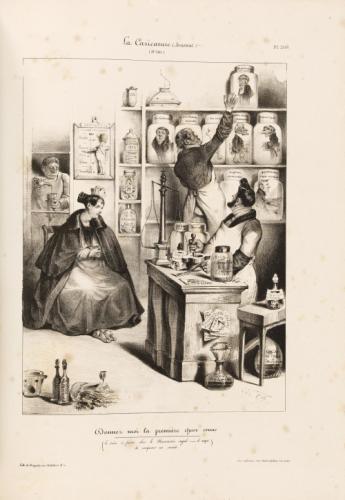
|
|
|
Grandville , Forest, Eugène-Hippolyte
E'lèvement des immondices - Lithographie sur velin blanc.
Planche HT parue dans La Caricature politique, morale, littéraire et scénique volume 4, 25 octobre1832 (Planche n°211)- Lithographie - Œuvre: Hauteur: 35.6cmx Largeur: 27cm - Image: Hauteur: 24.5cmx Largeur: 20.6cm - Titre en bas au centre : « Elèvement des immondices » ; indications, en ht au centre : « La Caricature (Journal) // N°103. », en ht à dte : « Pl. 211. » - Dans la lettre : « Lith. de Becquet, r. Childebert, 9. » [imprimeur], « On s’abonne chez Aubert, Galerie Véro-Dodat. » ; dans l’image, en bas à gche, signature : « G. F. » [Jean-Jacques Grandville, dessinateur, et Eugène Forest, lithographe]Inscription - Sous le pied droit du roi, deux feuilles avec inscriptions : « 60 » pour l’une, et « la v’la la grande // Ordonnance // qui vient de // paraitre // tout à l’heure » pour l’autre ; sous les pieds de d’Argout, deux feuilles avec inscriptions : « Exposition // Annuelle » pour l’une, et « BEAUX ARTS » pour l’autre ; aux pieds de Soult, deux feuilles avec inscriptions : « Circulaire » pour l’une, et « ETAT DE SIEGE » pour l’autre.iconographie:La table des matières du 4e vol. de "La Caricature" apporte une précision au titre : « (Promotion des 60 pairs) ». Louis-Philippe, à gche, pousse avec un balai vers la pelle de d’Argout des figurines représentant les pairs de France prêts à être jetés dans la charrette qui les emmènera vers le « PALAIS DU LUXEMBOURG ». Soult, à dte, en jette quelques-uns avec sa pelle. Les hommes sont habillés en charetiers. Une poire se trouve dans le coin inf. droit. La pl. dénonce la nomination de soixante pairs de France. Le titre joue sur la ressemblance entre les mots « enlèvement » et « élèvement ».Personnages représentés:Soult, Nicolas-Jean de Dieu; Argout, Antoine Maurice Apollinaire d', baron; Louis-Philippe Ier, roi des Français
书商的参考编号 : 25646
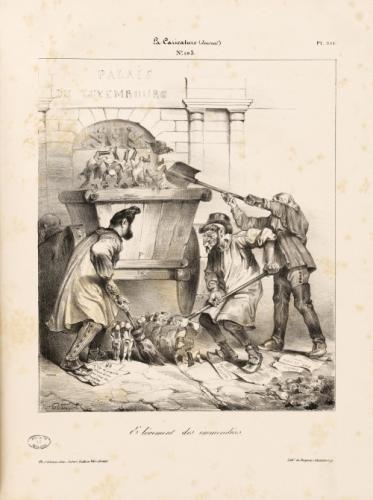
|
|
|
Grandville , dessinateur-lithographe - Julien, Bernard-Romain, dessinateur-lithographe
Ecritoire monarchique . Lithographie sur blanc.
Planche numérotée 298, publiée dans le journal la Caricature n°142 du 25 juillet 1833- Lithographie,taches en marge - Œuvre: Hauteur: 27.2cmxLargeur: 36.1cm
书商的参考编号 : 25648

|
|
|
Grandville - Forest, Eugène-Hippolyte
Encore une fois… Madame, voulez vous ou ne voulez vous pas divorcer, vous êtes parfaitement libre (IFF 43).Lithographie originale en noir sur Velin blanc.
1832 Lithographie - Planche HT parue dans La Caricature morale, religieuse, littéraire et scénique, volume 3, 9 février 1832, (Planche n°135) - Œuvre :Hauteur: 27cmx Largeur: 35.6cm - Image: Hauteur: 19.1cmx Largeur: 23.4cm- Titre en bas au centre : « Encore une fois… Madame, voulez vous ou ne voulez vous pas divorcer, vous êtes parfaitement libre. » ; indications, en ht au centre : « La Caricature (Journal) / (N°67.) », en ht à dte : « Pl. 135. »- Dans la lettre : « Lith. de Delaporte. » [imprimeur], « On s’abonne chez Aubert, galerie véro dodat. » [éditeur] ; dans l’image, en bas à gche, signature : « JJ. Grand / E. For. / H. Del. » [Jean-Jacques Grandville, dessinateur, Eugène Forest, lithographe, et « H. Del. » ( ?)]Inscription - Sur le papier tenu par Louis-Philippe : « Loi Du / Divorce / 1831 / Article » ; sur les papiers posés sur la table : « Promesse / avec […] », « Allian[…] [Alliance] / Liber[…] [Liberté] », « HOTEL / DE / VILLE » (allusion au prétendu programme de l’hôtel de ville auquel se référa fréquemment l’opposition républicaine, mais dont Louis-Philippe nia l’existence); sur les journaux jonchant le sol en bas à dte : « NÉMÉSIS », « LA CARICATURE », « La Tribune », « La Révolu[…] [Révolution] / de 1830 » (journaux de l’opposition); sur les cadres accrochés au mur du fond : « VALMY », « Jemmapes » ; à gche sur le mur, étiquettes d’un calendrier avec les dates des Trois GlorieusesDescription iconographique:La table des matières donne une précision sur le titre : « Le divorce d’Harpagon et de la Liberté ». Scène de ménage entre Louis-Philippe et la figure de la France républicaine, incarnée par une femme portant un bonnet phrygien à cocarde tricolore. Le roi brandit la loi du divorce de 1831 de la main gche et une masse de la main dte. Tous les éléments présents dans cet intérieur tendent à rendre sensible le décalage entre la fidélité aux idées républicaines rappelée par le roi (pendule de l’hôtel de ville, pavé de la révolution de juillet sous verre, tel une relique, son engagement révolutionnaire dans les batailles de Jemmapes et Valmy rappelé dans les tableaux accrochés au mur), et la réalité, c’est-à-dire, son éloignement de l’idéal révolutionnaire (coq enchaîné, buste brisé de La Fayette, journaux de l’opposition jetés à terre), et traitement infligée à la République, son épouse, dont il veut divorcer. La pl. met ainsi en lumière la volonté du roi de rompre avec les principes républicains.En outre, la pl. constitue une allusion à la loi sur le rétablissement du divorce qui venait d’être votée par la Chambre des députés (janvier 1832) et rejetée par les Pairs. Sur le même thème, cf. article du numéro 47, p. 367-370.Personne / Personnage représenté:Du Motier de La Fayette, Gilbert, marquis; Louis-Philippe Ier, roi des Français
书商的参考编号 : 25248
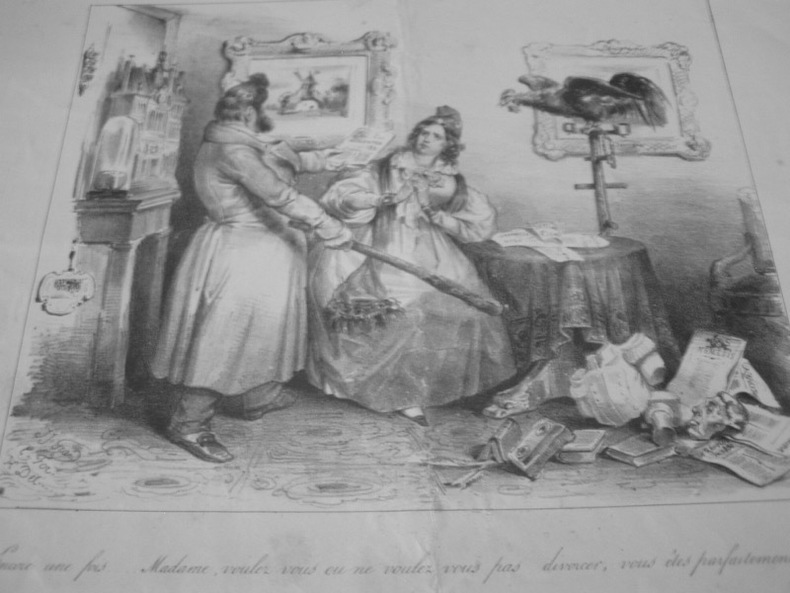
|
|
|
GRAVURES - LEVASSEUR et Cie.
Estampes et Gravures. 1907.
Paris, A. Levasseur et Cie, Editeurs-Imprimeurs, 1907; catalogue grand in-8° broché, couverture vert bronze, décor floral en noir avec titre doré et adresse en noir au 1er plat ; 56pp.Quelques piqûres à l' intérieur de la couverture sinon bon exemplaire.Texte imprimée en rouge orangé, et reproduction des gravures en noir.
书商的参考编号 : c5983
|
|
|
GRASSET de SAINT SAUVEUR Jacques (GRAVURE)
Femme de oonolashka
Gravure a l'aquatinte du 18e siecle (1788) par Laroque, d'apres le dessin de Grasset St Sauveur, imprimee sur papier vert. Coloriee a la main a l'époque.Encyclopédie des voyages,Kolorierte Aquatinta, Darstellung: 11 x 17 cm- - Alaska North America US
书商的参考编号 : 17280b
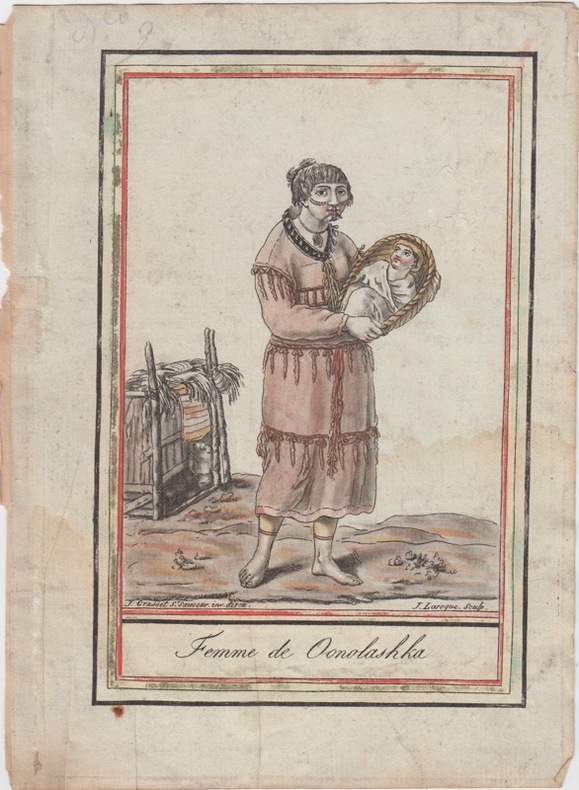
|
|
|
GRASSET de SAINT SAUVEUR Jacques (GRAVURE)
Femme des Isles des Amis
Gravure a l'aquatinte du 18e siecle (1788) par Laroque, d'apres le dessin de Grasset St Sauveur,Coloriee a la main a l'époque.Encyclopédie des voyages,Kolorierte Aquatinta, Darstellung: 11 x 17 cm;Tonga
书商的参考编号 : 17284

|
|
|
GRASSET de SAINT SAUVEUR Jacques MARECHAL, Sylvain.(GRAVURE)
FEMME MORDWINE en costume de noces,Costumes civils actuels de tous les peuples connus, dessinés d'après nature, gravés et coloriés, accompagnés d'une note historique sur leurs coutumes, moeurs, religions, etc
Gravure a l'aquatinte du 18e siecle (1788) par Labrousse, d'apres le dessin de Grasset St Sauveur,Coloriee a la main a l'époque.Encyclopédie des voyages,Kolorierte Aquatinta, Darstellung: 11 x 17 cm
书商的参考编号 : 17452

|
|
|
GRASSET de SAINT SAUVEUR Jacques MARECHAL, Sylvain.(GRAVURE)
FEMME Pretresse de Juida,Costumes civils actuels de tous les peuples connus, dessinés d'après nature, gravés et coloriés, accompagnés d'une note historique sur leurs coutumes, moeurs, religions, etc
1788 1788 Gravure a l'aquatinte du 18e siecle (1788) par Laroque, d'apres le dessin de Grasset St Sauveur,Coloriee a la main a l'époque sur papier vert.Encyclopédie des voyages,Kolorierte Aquatinta, Darstellung: 11 x 17 cm
书商的参考编号 : 17531

|
|
|
GRASSET de SAINT SAUVEUR Jacques MARECHAL, Sylvain.(GRAVURE)
FEMMES DE KALUGA,Costumes civils actuels de tous les peuples connus, dessinés d'après nature, gravés et coloriés, accompagnés d'une note historique sur leurs coutumes, moeurs, religions, etc
1788 1788 Gravure a l'aquatinte du 18e siecle (1788) par Labrousse, d'apres le dessin de Grasset St Sauveur,Coloriee a la main Encyclopédie des voyages,Kolorierte Aquatinta, Darstellung: 11 x 17 cm
书商的参考编号 : 20566
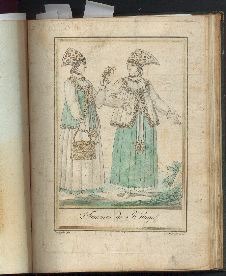
|
|
|
GRASSET de SAINT SAUVEUR Jacques (GRAVURE)
femme noble du Perou.Costumes civils actuels de tous les peuples connus, dessinés d'après nature, gravés et coloriés, accompagnés d'une note historique sur leurs coutumes, moeurs, religions, etc
Gravure a l'aquatinte du 18e siecle (1788) par Labrousse, d'apres le dessin de Grasset St Sauveur, imprimee sur papier vert. Coloriee a la main a l'époque.Encyclopédie des voyages,Kolorierte Aquatinta, Darstellung: 11 x 17 cm
书商的参考编号 : 24555
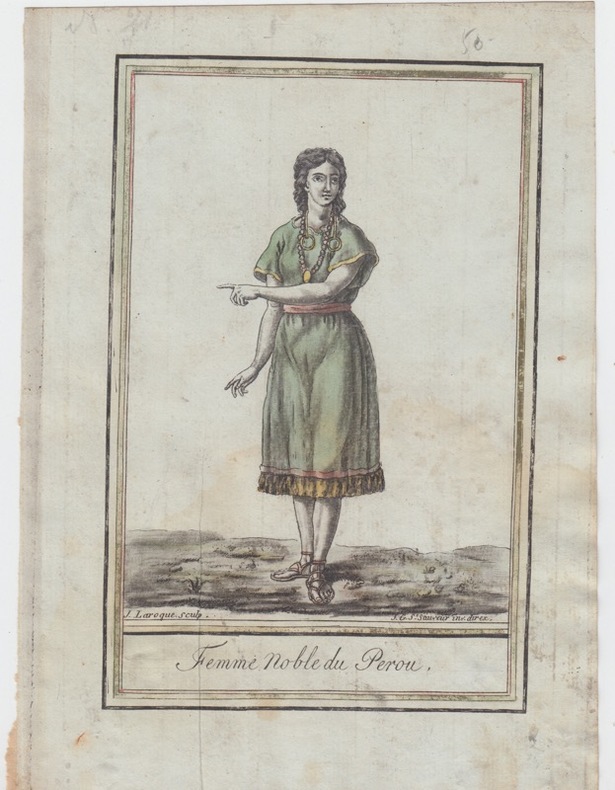
|
|
|
Grandville & Julien.TALLEYRAND
Gare les Quilles (bewarethe skittles)
1832 La Caricature. Journal. Morale, Religieuse, Littéraire, Scénique - La Caricature ( Journal) No 93. Pl[anche] 189. [Paris] Becquet for Maison Aubert [16 August 1832]. Lithograph. Overall paper size: 21.3 × 32.6cm.; caricature de Grandville et Julien, parue sous le n° 93 dans le journal La Caricature, le 16 août 1832. Talleyrand est à terre , pour "ramasser et remettre en place " les souverains et les princes européens que la "Liberté", invisible ici, s'apprête à faire tomber. C'est don Miguel, roi du Portugal, que le diplomate tient dans sa main droite. A demi caché, le jeune duc d'Orléans, fils aîné du roi Louis-Philippe.Satirical print showing an allegory of Liberty fighting against the monarchical principle by attempting to upset the political arena with a revolutionary bowl. Her opponent in the ‘bowling alley’, a barren hillside outside a castle, is the seasoned diplomat Talleyrand, who is sitting on the ground facing her, his crutch visible to the right. The skittles are miniature images of European princes; King Louis Philippe is recognizable from behind in the centre of the print, and half-hidden in front of him, is his eldest son, the young Ferdinand-Philippe Duc d’Orleans. Supporting himself with his left hand, Talleyrand has restored to its place the diminuative effigy of Dom Miguel I, the auto- cratic young ruler of Portugal, with his right hand.A vitriolic caricature of all members of the July Monarchy govern- ment, mocking its repression of the opposition, and its weak foreign policy. Louis Philippe, represented as a fat, effeminate king wearing a toga, is accompanied by a decadent family and scheming, corrupt ministers. The composition is dominated by Talleyrand to the left who is portrayed as Vulcan, forging chains and protocols. He is sitting on netting with which he ensnares the world; a fleur-de-lys is tattooed on his right forearm; his orthopaedic shoe is on the correct foot and his crutch is partly buried under documents to his right.
书商的参考编号 : 24403
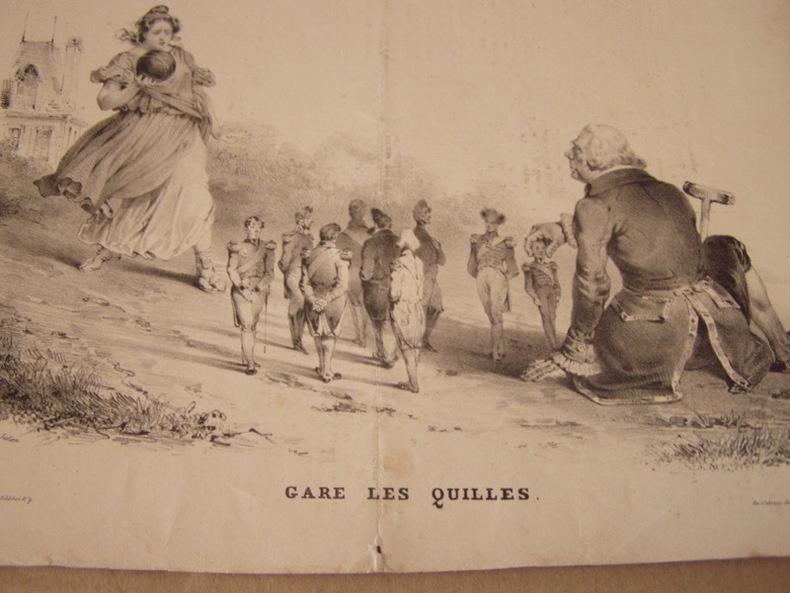
|
|
|
Grandville , dessinateur- Roubaud, Benjamin (dit Benjamin) , dessinateur- Forest, Eugène-Hippolyte , dessinateur-lithographe
Grand enterrement du gros Constitutionnel décédé en son hôtel rue Montmartre N°121, enface [en face] de l’apothicaire et du Marchand de Brioches.Lithographie double sur blanc.
1834 Planche HT parue dans La Caricature politique, morale, littéraire et scénique, volume 7, 16 janvier 1834 (Planche n°351-352) - Vic. col. 72.- Lithographie, Pli vertical médian - Œuvre: Hauteur: 35.5cmx Largeur: 52.5cm - Image: Hauteur: 28.3cmx Largeur: 46.3cm - Titre en bas au centre : « Grand enterrement du gros Constitutionnel décédé en son hôtel rue Montmartre N°121, enface [en face] de l’apothicaire et du Marchand de Brioches. » ; légende plus bas au centre : « Cet infortuné vieillard tombé, après la révolution de Juillet, dans l’enfance et le philippisme fut attaqué de tous les fleaux [fléaux] qui marquerent [marquèrent] ce temps de calamités publiques, la croix dite d’honneur, la poignée de main, la truffe ministérielle enfin, il mourut frappé de l’affreux // désabonnement et s’éteignit dans les bras de ses actionnaires St. Albin (le Rousselin de 93) Chevassus (jadis attaché à la personne de Mr. de Stael) Jay (ancien censeur), Etienne (ancien censeur) », « que la terre te soit légère, ô naif [naïf] Constitutionnel !.... De profundis. » ; indications : en ht à gche : « La Caricature (Journal) N°167. », en ht à dte : « Pl. 351. 352. » - Dans la lettre : « Chez Aubert, galerie véro dodat. » [éditeur], « L. de Becquet, rue Furstemberg 6. » [imprimeur] ; dans l’image, en bas à dte, signature : « JJ. Grandville X Benjamin // EF » [Jean-Jacques Grandville et Benjamin Roubaud, dessinateurs, et Eugène Forest, lithographe]Inscription - Grandville porte les « titres de gloire » (in explication) du journal : « articles Béotiens // banc d’huîtres // Lune de Mme de Sevigné. // Araignée diletante // Cosmétiques de Mme Ma // Articles Charadias de Mr XXX // horizons Politiques // Culte du vrai // napoles tricorniger // Fusées chromatiques // vaisseau de l’état // char de l’état ». Un pâtissier présente devant lui un registre comportant une colonne de nombreux « desabonnés [désabonnés] » et une colonne vide d’ « abonnés ». Sur l’affiche sur le mur de gche : « VENTE // par [suite ?] de décès // s’adresser // rue montmartre n°121 // en face le marchand de brioches ». Inscription en haut du mur à dte : « AUX LARMES D’ARGENT // denoyers fabricant de tombes épitaphes mausolées [ ?] »
书商的参考编号 : 25632

|
|
|
Graham CLARKE (1941- )
Graham Clarke, gravure originale : "Mullion Cove" 1976. Titrée, numérotée 286/350 et signée au crayon.
49x61 cm. Sur papier vélin filigrané "hand made 1976 HAYLE MILL ". Mouillure angulaire, sinon très bon état.
书商的参考编号 : 83431
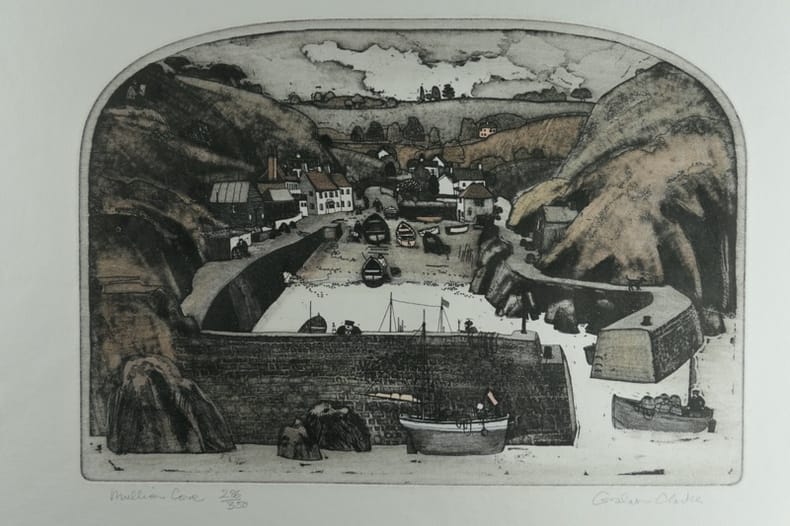
|
|
|
GRASSET de SAINT SAUVEUR Jacques (GRAVURE)
Guerrier Peruvien,Costumes civils actuels de tous les peuples connus, dessinés d'après nature, gravés et coloriés, accompagnés d'une note historique sur leurs coutumes, moeurs, religions, etc
1788 1788 Gravure a l'aquatinte du 18e siecle (1788) par Labrousse, d'apres le dessin de Grasset St Sauveur,Coloriee a la main a l'époque.Encyclopédie des voyages,Kolorierte Aquatinta, Darstellung: 11 x 17 cm
书商的参考编号 : 24550
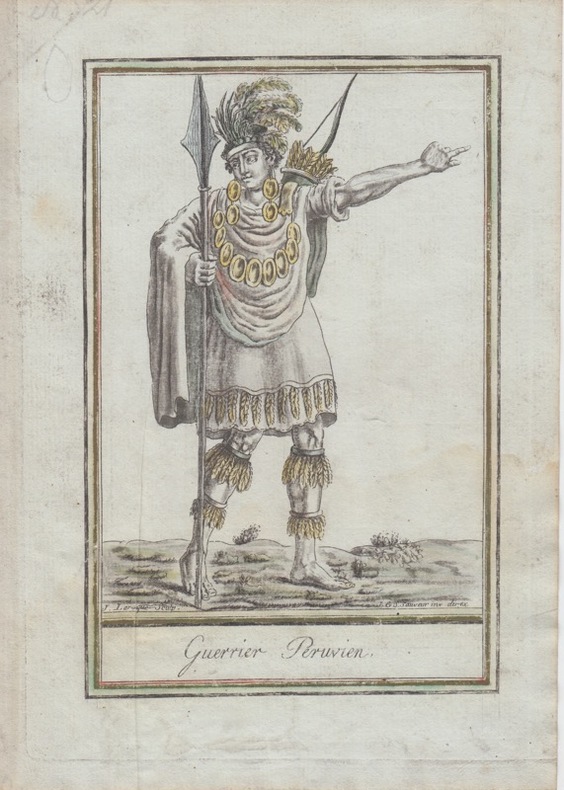
|
|
|
GRASSET de SAINT SAUVEUR Jacques (GRAVURE)
homme de l'isle de Ste Christine.
1788 1788 Gravure a l'aquatinte du 18e siecle (1788) par Laroque, d'apres le dessin de Grasset St Sauveur, Coloriee a la main a l'époque.Encyclopédie des voyages,Kolorierte Aquatinta, Darstellung: 11 x 17 cm
书商的参考编号 : 17272

|
|
|